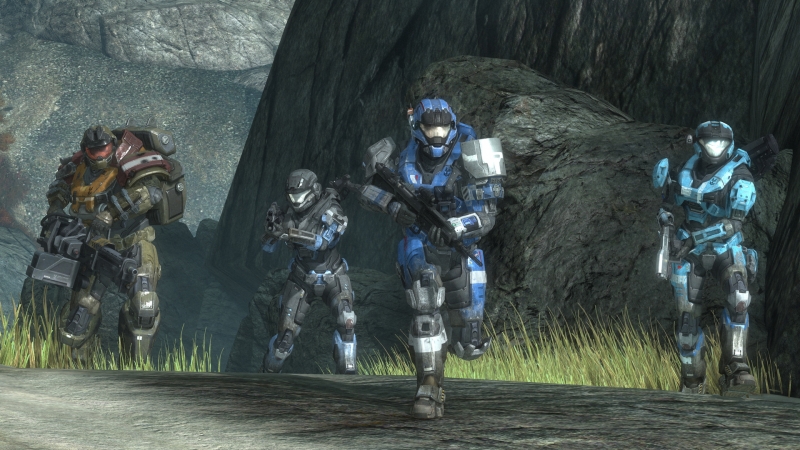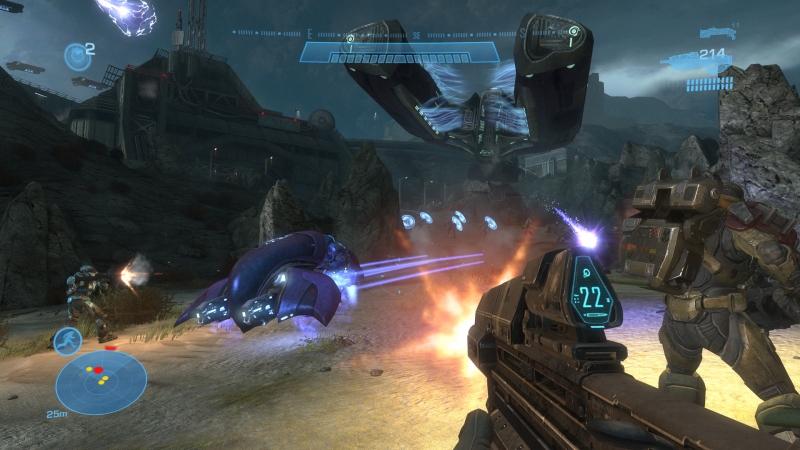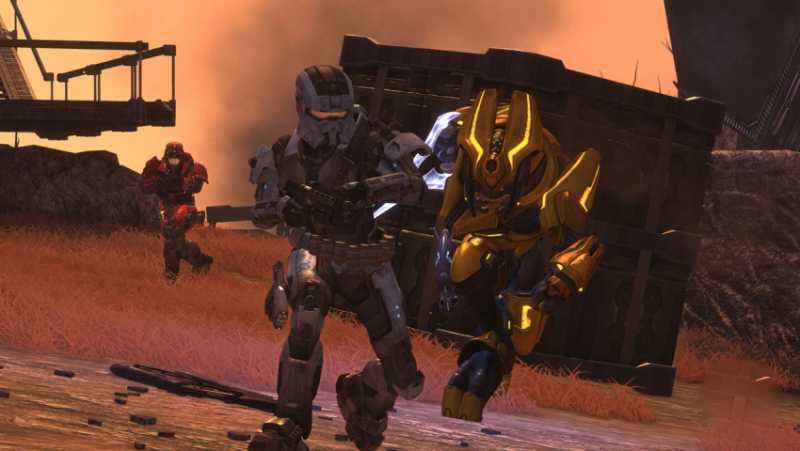Upon Halo 3’s release in 2007, Microsoft and Bungie were faced with a dilemma: what now? How does one craft a follow-up to a game whose own marketing included the memorable call-to-arms to ‘Finish the Fight’? Where do you take the series when its protagonist is drifting aimlessly through deep space? The answer it seems, is to go back to the beginning.
Halo Reach is set before the events of 2001’s Halo: Combat Evolved and follows Noble Team, a squad of Spartan IIIs, in their struggle to survive the unwavering onslaught of a Covenant invasion. The game, set during events detailed in Eric Nylund’s novel The Fall of Reach, depicts the final days of the titular planet. From the start, it’s clear that Reach is the darkest Halo title to date and it is this note of finality which lends the narrative so much weight. Unfortunately, the game’s characterization doesn’t match up to the plot.

Noble Team comprises of six Spartans: Carter, Kat, Emile, Jorge, Jun and an unnamed newcomer identified by the call-sign Noble Six. Players assume the role of Noble Six, a ‘hyper lethal vector’ who subscribes to the Gordon Freeman school of mute FPS protagonists. The traditional reasoning behind this is to allow gamers complete ownership of a blank slate, allowing us the freedom to craft a more personal narrative in the universe. In past Halo games, this philosophy worked just fine, but Reach falters because the characters surrounding Noble Six are nothing more than one-note archetypes. You’ve got the focused leader (Carter). A level-headed and reliable second in-command (Kat). The edgy rebel who likes encounters up-close and personal (Emile), and a towering heavy weapons specialist (Jorge). About the only interesting character is Jun, a sniper who goes against type by being on the chatty side. It’s a shame since the backdrop of Reach is arguably the most engaging in the series. Thankfully, the rest of Reach is brilliant.
Reach offers up a fantastic platter of options for gamers with an engaging and well-paced single-player campaign, a deep and varied suite of multiplayer options and Firefight, Halo’s take on the Horde mode popularized in Epic’s Gears of War series.

The ‘combat loop’ and battle sandboxes which propelled the first Halo title to such universal acclaim have been retained and polished to perfection. Reach features a number of genre standard weapons such as the assault rifle, shotgun and sniper rifle. Although the removal of the battle rifle might seem like a misstep, its replacement, the designated marksman rifle (DMR), easily fills the void. Add to that the plethora of Covenant weapons and you’ve got enough arms to suit any gamer’s taste. That said, it helps that gunplay is tight and responsive, since the game boasts some truly challenging AI.
Covenant troops will flank your position, seek cover and attempt to flush you out with grenades on the higher difficulty levels. Played on Legendary, the highest difficulty setting, the game takes on new life as each and every encounter becomes a battle for survival. Reach allows for up to 4 players to tear through the campaign in co-op, thus adding another dimension to an already complex gameplay experience. But be warned, enemies scale up with each added player.
Halo’s multiplayer has always been one of the crown jewels of console gaming and Reach is no exception. Gamers can jump into games of classic modes such as Slayer, Team Slayer, King of the Hill, Oddball and Infection. But, if you’d prefer something with a more personal touch, there’s a huge list of customizable options. These options also extend to Firefight, in which you can determine conditions such as the number of enemy waves, weapon spawn points and load-outs. For this go around, Bungie has replaced Halo 3’s equipment with armor abilities. Unlike equipment which was an exhaustable item, armor abilities will stay with the player throughout the entire round. The abilities include jetpacks, armor lock and the self-explanatory sprint. This serves to inject a feeling of newness to the proceedings without shaking up the foundations of the tried and tested gameplay mechanics. All this is tied together by a persistent profile and an Armory system which contains armor permutations which you unlock through credits earned by playing the game. Finally, the Theater mode returns from Halo 3 and allows for capturing and sharing of screen grabs and videos. This adds up to a game packed to the brim with options for every gamer.

It must be noted that the visuals in Reach shame those found in previous Halo games. Every character model, weapon and environmental object has been rebuilt and it truly shows. With textures and lighting which push the aged Xbox 360’s hardware to its limit, this is inarguably one of the best looking games on the 360. Happily, the technical accomplishments are accompanied by some of the best art direction in the series. Futuristic cityscapes, billowing pillars of smoke stretching into a blood red sky and twisted alien structures are just some of the breathtaking creations gamers can see in this game. About the only issue with Reach’s visuals is noticeable slowdown when there are too many enemies on screen. Thankfully, it’s a rare occurrence and I’ve encountered it just a handful of times in over 150 hours with the game.
The audio in the game offers some sharp and punchy sound effects. From the howl of an Elite to the crack of the sniper rifle cutting through the night air, the game’s audio will transport you right into the thick of the action. To complement the brilliant effects, Bungie’s Martin O’Donnell is back with yet another rich and varied score which reflects the somber tone of the game. The tracks range from adrenaline pumping pieces such Tip of the Spear, to moody tracks such as Ashes. This is some of Marty’s finest work and is one of the best scores ever composed for a video game.
Halo Reach is Bungie’s love letter to the fans. It’s an incredibly polished package which caters to gamers of every taste and deserves a place in every 360 owner’s collection. Now if you’ll excuse me, I think I’ll get in a round of Gruntpocalypse. See you starside.



1 Comment
I’ve never been a big fan of shooters on the consoles since I’m a PC-FPS boy through and through. Still I must say that Halo Reach “nearly” converted me to join the console side.
“NEARLY” haha!